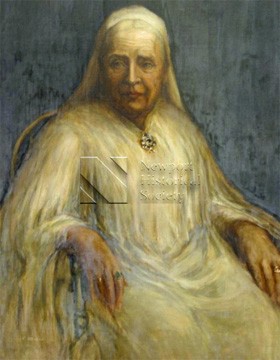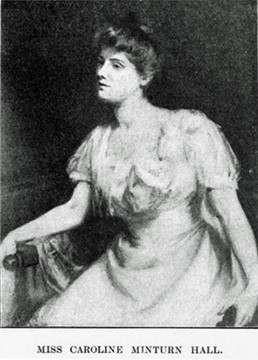Caroline Minturn Hall, 1874 – 1972
Caroline Minturn Hall was born in 1874 into a wealthy and prominent New England family in South Portsmouth, Rhode Island. Her grandmother was the famous Julia Ward Howe, American poet, abolitionist, and suffragist who composed "The Battle Hymn of the Republic" in 1862 to rally the Union army during the Civil War. As with many wealthy society women, there are few details about Caroline’s life before her marriage. Memoirs by her mother, Florence Howe Hall, provide some clues: the family moved to Plainfield, New Jersey when Caroline was a young woman. There, she met Mrs. George Richmond Fearing, who invited Caroline to travel with her to France to study the language and pursue her interest in painting. Hall lived in Paris for seven years, training with atelier masters Thaulow, Ménard, Collin, Delance, Courtois, and others. According to Florence Howe Hall, “Caroline’s decidedly American accent changed, in the seven years of her foreign residence, into something closely resembling the French of the natives” (255-256). Caroline, apparently the youngest student in Frits Thaulow’s class at the Académie Delécluse, was nicknamed “Baby Hall,” and joined the other art students to be critiqued by their Norwegian instructor in the Bois de Boulogne (Hall 256).
Fellow artist Maud Stumm's pencil drawing of Caroline Minturn Hall, preserved in the Newport Historical Society, has a handwritten note on the reverse acknowledging Hall's membership in the Girls' Art Club. Hall is also listed in the 1896 Indicateur guide as a resident of 4 rue de Chevreuse—she apparently lived there for several years while in Paris. In January 1903, The Baltimore Sun published an article about a meeting of the American Woman's Art Association (AWAA), headquartered at the Club. The article lists the officers of the Association for the coming year: Minturn had been elected secretary (she would later serve as vice president before returning to the United States). The president of the AWAA for that year was Mary Fairchild MacMonnies and Elisabeth Kruseman Van Elten was vice president (January 18, 1903, 5). Although records don’t indicate whether or not Hall exhibited at the 1903 AWAA exhibition, she was listed among the artists who showed their work in 1904- her painting, “The Pines on a Hill,” was praised by a critic for The New York Times (March 6, 1904, 4). Caroline also participated in the Salon des Beaux Arts, exhibiting a landscape painting and pastel drawing in 1905 as well as two pastel drawings in 1906.
Caroline returned to the United States in 1907, shortly before the death of her father. She and her mother moved from Plainfield, NJ to New York City, living in an apartment on Washington Square while Caroline worked in a studio in the Stokes building. Her mother recalled a number of Caroline’s one-woman shows in New York and in Newport, Rhode Island—the sale of several paintings helped defray the high costs of their living expenses (Hall 314). In 1909, Caroline married Rev. Dr. Hugh Birckhead, a Columbia University graduate and rector at St. George's Church in New York. The couple's engagement announcement, published in The Boston Globe, gives a fuller picture of Caroline's life in Paris:
Miss Hall studied seven years abroad under the best masters in Paris and other places, including Fritz Thaulow, the noted Norwegian. She took the first prize for drawing, a silver medal, at Delécluse academy in 1903. In 1905 and 1906 she exhibited at the salon of the Société Nationale des Beaux Arts. The merit of her work was recognized in her first picture 'The Wooded Vale,' which was hung on the line at the Champ de Mars and which was favorably noticed in the French press. Her work has been shown for several years at the exhibitions of the American women's art association of Paris (February 26, 1909, 5).
The wedding must have been an extravagant affair. It was widely reported in The Boston Globe, The New York Times, and even The Washington Post, which shared that a particularly prominent invitee could not attend: “Though J. Pierpont Morgan has sent his regrets because of his absence in Europe, he has sent a beautiful wedding gift to Miss Caroline Minturn Hall, who is to be married to the Rev. Hugh Birckhead, rector of St. George’s, in Stuyvesant Square, New York, this afternoon” (June 9, 1909, 7). The newlyweds honeymooned in Europe before settling in to their lives as rector and wife at St. George’s. After nearly three years in New York, Caroline and Hugh moved to Baltimore, where he accepted the call of Emmanuel Protestant Episcopal Church, hoping a smaller parish would enable him to focus on his growth as a preacher and a minister. Caroline is referenced in The Baltimore Sun article detailing the Birckheads’ move to Baltimore as “admittedly one of the best landscape painters in New York” (February 15, 1912, 5).
The Birckheads remained in Baltimore for 17 years and Hugh led the Emmanuel Church until his death of a cerebral hemorrhage in 1929. His obituary described his family legacy of ministry and noted that he could trace his American ancestry to settlers in Anne Arundel County, Maryland in 1662 (New York Herald Tribune, July 11, 1929, 21). It also described Hugh’s service in WWI, when he traveled to Europe as a special investigator for the Red Cross and delivered speeches in England about America’s role in the conflict.
Caroline continued to paint throughout her life, though not professionally, and she maintained memberships in several art associations, garden clubs, and the Newport Historical Society. She and her husband had two sons: Christopher, a government employee with the Department of the Interior, and Hugh, the younger son, who was an ornithologist at the American Museum of Natural History and a painter and sculptor of birds. Hugh was tragically killed in action in France during World War II. Caroline died at age 97 in 1972 (Newport Mercury, February 11, 1972, 3).
Sources
- “American Girl Abroad.” New-York Tribune, February 10, 1903, p.7. ProQuest Historical Newspapers.
- Dole, Nathan Haskell. “Julia Ward Howe and Her Talented Family.” Munsey’s Magazine, volume 42, number 5, February 1910, pp. 613-620. Google Books.
- Falk, Peter H. “Hall, Caroline Minturn.” Who Was Who in American Art, 1564-1975: 400 Years of Artists in America. Madison, CT: Sound View Press, 1999, p. 210.
- Foreign Correspondence. "Paris Art News." The New York Times, March 6, 1904, p. 4.
- Hall, Florence Howe. Memories Grave and Gay. New York: Harper & Brothers Publishers, 1918.
- “In the Public Eye.” Harper’s Bazar, vol. 41, no. 5, May 1907, p. 460. ProQuest.
- “Miss Hall to Wed Rev. H. Birckhead.” The New York Times, February 25, 1909, p. 7.
- “Mrs. Birckhead, Dies, Julia Ward Howe Kin.” Newport Mercury, February 11, 1972, p. 3. Newspapers.com.
- “Portrait of Julia Ward Howe.” New-York Tribune, April 8, 1908, p. 5. ProQuest Historical Newspapers.
- “Society Outside the Capital.” The Washington Post, June 9, 1909, p. 7. ProQuest Historical Newspapers.
- Special to The Baltimore Sun. “Themes in Gay Paris.” The Baltimore Sun, January 18, 1903, p. 5. ProQuest Historical Newspapers.
- Special to the Herald Tribune. “Dr. Birckhead, Veteran Rector, Dies in Newport.” New York Herald Tribune, July 11, 1929, p. 21. ProQuest Historical Newspapers.
- “Talented Granddaughter of Mrs Julia Ward Howe.” Boston Daily Globe, September 8, 1907, p. 40. ProQuest Historical Newspapers.
- “To Wed in June: Engagement of Miss Hall Arouses Interest.” Boston Daily Globe, February 26, 1909, p. 5. ProQuest Historical Newspapers.
- “Why He Leaves New York.” The Baltimore Sun, February 15, 1912, p. 5. ProQuest Historical Newspapers.

![Maud Hamm [should be Maud Stumm], "Caroline Minturn Hall", 1895, pencil drawing, Newport Historical Society Maud Hamm [should be Maud Stumm], "Caroline Minturn Hall", 1895, pencil drawing, Newport Historical Society](/sites/default/files/styles/cu_crop/public/content/Hall%2C%20portrait.jpg?h=e47ff0f7&itok=BWr9r6le)
![Caroline M. Hall [attributed to], "Hilly coastal landscape," n.d., oil on canvas. Invaluable.com Caroline M. Hall [attributed to], "Hilly coastal landscape," n.d., oil on canvas. Invaluable.com](/sites/default/files/styles/cu_crop/public/content/Hall%2C%20coastal%20landscape.jpg?itok=8_oCEuXB)
